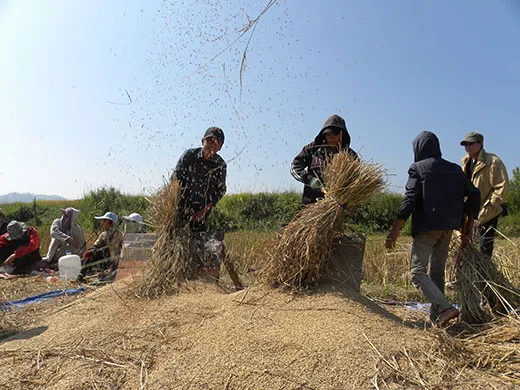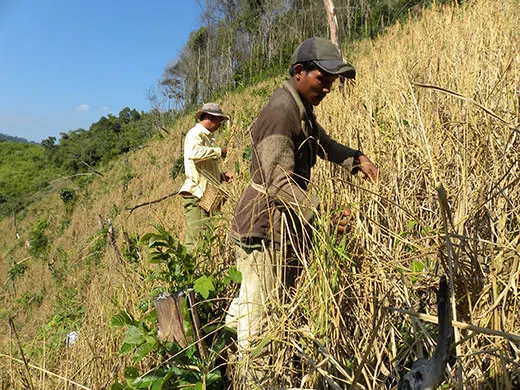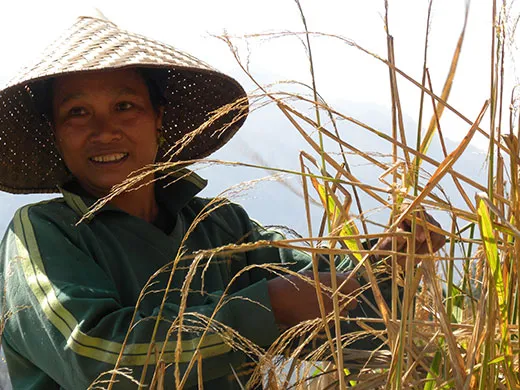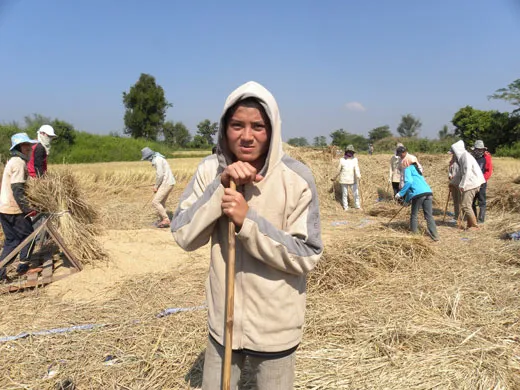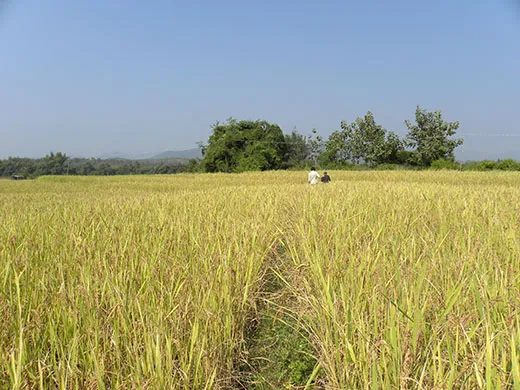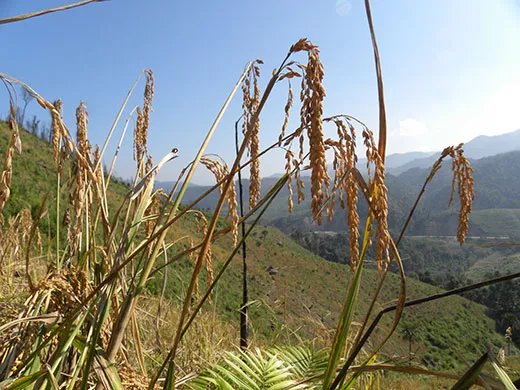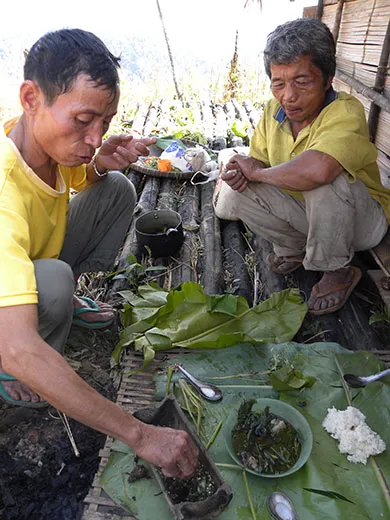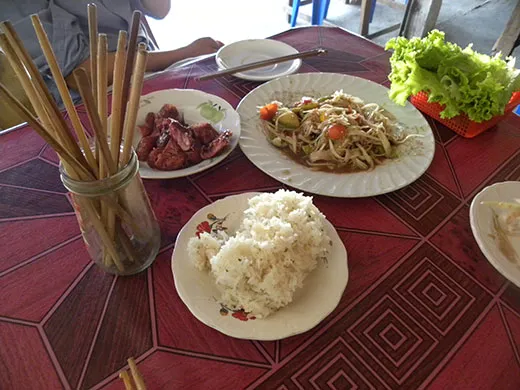A Taste of Sticky Rice, Laos’ National Dish
One cannot travel to the Southeast Asian country without many meals of sticky rice, the versatile staple of Laotian cuisine
/https://tf-cmsv2-smithsonianmag-media.s3.amazonaws.com/filer/Sticky-rice-Laos-631.jpg)
Luck was losing patience, and his stomach was grumbling like the diesel engine of the bus transporting him to northern Laos. He needed to eat sticky rice, he said, so badly!
He checked his cellphone: No service. Slumping into his seat, he looked out the windows — but it was mid-November in the Lao People’s Democratic Republic, and in field after field, Laotian farmers were harvesting sticky rice and burning the discarded husks for fertilizer. Luck sighed. The smoky air carried a sweet, ricey aroma.
It was the first day of a six-day, northbound journey from Vientiane, the tranquil capital, to a remote village near the Laos-China border. Luck — short for Vilayluck Onphanmany — is my 23-year-old Laotian friend and translator whom I’d met on my first of three previous trips to the landlocked Southeast Asian country. He was assisting a gastronomic investigation: a friend and I were on a mission to learn the secrets of sticky rice, the mainstay of Laotian cuisine, and in the process, to eat as much of it as possible.
When our bus rattled into a dusty market, a group of women crowded the windows. “Ao khao bor?” they called (“Do you want sticky rice?”). Luck snapped to attention and called for two bags — one for me and my traveling companion, and one for himself. We ate with our hands, Laotian-style. Luck finished his portion before the bus started rolling.
“I feel better!” he said, and promptly dozed off. Other passengers were either eating sticky rice or, like Luck, sleeping it off.
What explains the national love of sticky rice? Many Laotians laughed when I asked them. Sticky rice is what their grandparents and great-grandparents ate, they said. Perhaps they were caught off guard by my question: like baguettes in France and sushi in Japan, sticky rice is so ingrained in Laos’ culinary heritage that most Laotians don’t think about it in isolation.
Sticky, or “glutinous,” rice has been growing in mainland Southeast Asia for at least 4,000 years. Historians debate whether ancient farmers grew sticky rice because it was suited to local growing conditions or because they liked its taste and chewy texture. What’s clear is that, by the 18th century, sticky rice had been largely replaced across the region by varieties of non-glutinous rice, a.k.a. “white rice.”
But sticky rice is still the primary staple in Laos parts of the five countries bordering it: China, Myanmar, Thailand, Cambodia and Vietnam. In Laos, slightly larger in area than Utah, per-capita sticky rice consumption is the highest on earth at more than 345 pounds per year. The average American, by contrast, eats less than 20 pounds of rice annually, according to the United States Drug Administration.
Urbanization, migration and other forces are altering rice-consumption habits across Laos, says historian Grant Evans, to the point where some urban dwellers now associate sticky rice with “country bumpkin ways of eating.” But Evans, the author of several books about Laos, also says he doesn’t know a single Laotian person who never eats sticky rice. From a cultural perspective, he explained, sticky rice is still “the way the Lao identify themselves.” Case in point: as of the mid-1990s, a popular Laotian band in the United States was calling itself Khao niaw — the Laotian words for, sure enough, sticky rice.
The dish comes in various shapes and sizes — a recent agricultural research project on rice in Laos involved more than 13,000 rice samples, more than 11,000 of them glutinous — but the basic method of consuming khao niaw is the same countrywide. Harvested sticky rice grains, which are typically shorter and fatter than non-glutinous ones, are soaked overnight, steamed in the morning and eaten all day.
Sticky rice still tastes great after two steamings, said Luck, but steaming it thrice makes it “too sticky.” Because sticky rice lacks the starch amylose, it congeals — and breaks off into fist-sized pieces — more easily than white rice under similar cooking conditions.
A hunk of sticky rice is a delicious, bread-like dipping implement. Laotians prefer to eat sticky rice with non-soupy dishes, rather than with just curries and sauces, said Caroline Gaylard, co-founder of Tamarind, a café and cooking school in Luang Prabang, the former Laotian royal capital. According to Gaylard, an Australian who moved to the country, sticky rice complements the popular Laotian dish jeow, a dry paste made from chili peppers and herbs, as well as the royal dish mok pa fork, which features steamed fish, dill, shallots and coconut milk.
Sticky rice figures in religious traditions across Laos, where the predominant faith is Theravada Buddhism. Laotians cook sticky rice dishes — notably khao tom, a fusion of sticky rice, coconut, banana and mung bean — for ceremonies related to plantings, rainfall, harvests and death. During the popular baci ceremony, uncooked sticky rice grains are tossed into the air after communal prayers. And when a Laotian is dying, a village elder may rub sticky rice on the person and throw the rice away to banish bad spirits.
But sticky rice isn’t merely spiritual fuel. Because it takes longer to digest than white rice does, it sates hunger for longer periods. That’s good for Laotian monks, who generally don’t eat after midday. “People give us only sticky rice, which is awesome,” said Sary Phonesay, a 19-year-old monk with brown eyes and a gentle smile. He was standing in the sun-dappled courtyard of a Buddhist temple in Luang Prabang, where tourists line up each morning like band groupies outside of a stadium box office to place steaming clumps of khao niaw into the monks’ collection pots. When I asked why he prefers sticky rice to white rice, the monk said, “If I eat sticky rice, I’ll be full longer.” Laotian farmers I asked repeated variations of Sary’s explanation. Agriculture, mainly subsistence rice farming, employs three out of four Laotians. Sticky rice packs well in banana leaves and is a common field-side snack.
Sticky rice grows in Laotian lowlands and uplands. Lowland farmers plant it in flooded paddies; upland farmers intercrop it on hillsides with companion crops like taro, cassava and chili peppers. Because hillsides generally receive less-predictable supplies of water than paddies do, hillside rice fields tend to be more susceptible to drought.
Curious about hillside sticky rice, my friends and I rode an overnight bus from Luang Prabang to Luang Namtha, a one-lane town near the Laos-China border. At a Luang Namtha eco-outfitter, we asked a friendly guide to take us into the surrounding countryside and introduce us to hillside sticky rice farmers. We cruised out of town on rented motorbikes. The passing landscape alternated between forests, rubber plantations, thatch-roof houses and cleared hillsides whose golden color reminded me of California’s Santa Ynez Valley.
Soon we were hiking near a sleepy village whose sign read Khoua Soung. Farmers from the Kmhmu ethnic group were harvesting sticky rice on a distant hillside. As we approached russet-colored rice stalks, Luck praised the view: he had sketched similarly pastoral scenes in primary school, he recalled, but always from his imagination. “We’re not in the lowlands anymore,” said Luck, whose white headphones were playing Laotian pop music from a pocket MP3 player. “Those people have to stand up all day, and they don’t have any technology to help!”
Indeed, most Kmhmu people are upland subsistence farmers, and they use decidedly low-tech production techniques. Men and women stripped sticky rice grains by hand from mature stalks, then dropped the grains into woven baskets attached to their hips. After dumping the rice into white sacks, they carried the sacks down the hill.
Rural development experts told me that many Laotian farmers wage a constant battle against food insecurity. The farmers of Khoua Soung were no exception: Because of drought and rodent infestations, they said, 16 of their village’s 57 families wouldn’t harvest enough sticky rice this year to meet their own needs. “In the cities, they eat sticky rice for taste,” said Juelang, a quiet farmer who was drinking water from a plastic motor-oil can. “Here we eat it for survival.”
Over an evening bonfire in Khoua Soung — a roadside cluster of wooden stilt houses — farmers discussed survival strategies. Some were selling rubber sap and wild cardamom to Chinese traders; others were selling rice-harvesting baskets to tourists. If all else failed, said 41-year-old farmer Han Tom Keo, needy farmers would borrow sticky rice from their neighbors.
The threat of hunger didn’t diminish their hospitality. As stars replaced the sun in a cloudless sky, the farmers invited us into a stilt house and served us spicy jeow, pickled bamboo shoots, fresh chicken soup and steaming hunks of khao niaw. I handled my sticky rice carefully, conscious of how much elbow grease had gone into each grain. We ate and chatted, and ate some more, until about 8 p.m.. Afterward we were so full that we went directly to bed.
Lying under a mosquito net in the head villager’s drafty stilt house, I listened for sounds of evening activity. Silence. The farmers were sleeping, and for good reason: There was more sticky rice to harvest, starting at daybreak.
Mike Ives is a freelance writer based in Hanoi, Vietnam.
Planning Your Next Trip?
Explore great travel deals
Smithsonian magazine participates in affiliate link advertising programs. If you purchase an item through these links, we receive a commission.
